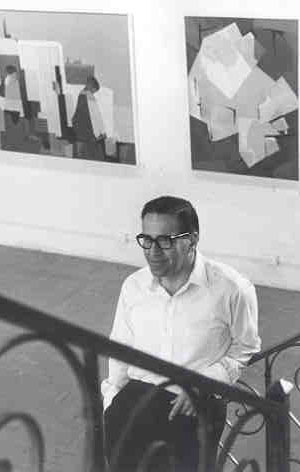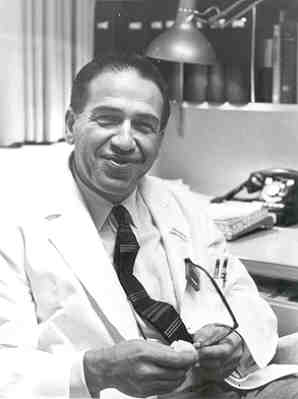
|
CONTEXT:
ARTIST'S PERSONAL STATEMENTS & PHOTOS
"Warriors of the High Tech" (1985) "Zepa's Studio" (1985) "Whimsies Ancient and Modern" (1988) The Artist at the Encina Gallery (1966) The Doctor in his Office (1969) |
|||||||||||||||||
|
"Warriors
of the High Tech" Exhibition (1985)
My encounter with bronze sculpture in 1971 was the result of a gift of a slab of sculptor's wax from my friend Carrie Abramowitz, and a 2 week Christmas vacation, resulting in explosive activity and the making of 21 sculptures which were cast using the lost wax process. I spent the next 6 months finishing them. The bronzes depict in semi-abstract fashion various aspects of the nature of man, his genesis, the duality of mind and body, his family and social organization, his spirit, his work, and destiny. A group of them depict symbolic men of strength or power, including warriors, priests, and survivors of earlier cultures. The cast resin pieces were done in the summer of 1974, the output of a sculpture course I took under Richard Randall, at Stanford. I learned a great deal about technique from him. Working "in the dark" with molds and casts was a new experience. I find I prefer to be able to change as I go. As a sculptor, I'm an assembler, not a carver. In late 1975 during a visit to Baja California, we saw a remarkable tiny cemetery at the very tip, at Cabo San Lucas. By that time I had also become interested in the writings of Carlos Castaneda, especially his philosophy of self-preservation, death as an advisor, and the concept of personal power. Two months later I was felled by a totally unexpected heart attack. During the convalescent period my thoughts returned to that little cemetery and to Casteneda's writings. When I began to paint again, the result was the Cabo San Lucas series. In my mind they deal with resolve, death, struggle, triumph, harmony, and peace. In 1982 several events occurred which subsequently influenced my work considerably: I began a two-year period of study of monotype technique with Nathan Oliveira at Stanford and each of my daughter-in-laws presented me with a grandson. Later my grandsons and I were to have great fun together in my studio. My technique became more spontaneous, experimental and whimsical. A happy combination of accidental events culminated in the series of 40 wood figures called Warriors of the High Tech, all completed within a 6 week period of intense activity. Warriors have had a special meaning for me (see my earlier encounter with them in the bronze works.) The concept of warrior implies struggle, courage, difficulty of task, an urge not only to survive but to prevail; originality and individuality of dress, thought, and behavior; choice and tailoring of weapons according to the strengths and skills of the warrior and the weakness of the foe; concern with combat strategy and its planning; responsibility personally for executing a plan of action, frequently against heavy odds; determination, persistence and strong will; adherence to principle -- a free spirit, vital, purposeful, and honorable; a protector and a preserver of heritage. back to top |
|||||||||||||||||
| "Zepa's
Studio " Exhibition (1985) Zepa (a combination of Zeda and Grandpa) is the name given to me by my grandsons Jesse and Aaron, aged 3 and 2 when the work in this exhibit was done (August, 1984). Aaron was then visiting his cousin Jesse. My studio is well equipped and stocked with supplies of all kinds, and their desire to paint in it was obvious. From the beginning, I made a conscious choice to given them free rein in the studio. They could choose any medium, any color or combination of colors, any brush, any size and type of surface to work on. I gave no instruction, made no suggestions, and asked no questions. The decision when to stop was theirs. I simple faciliated their access to the materials and made them as comfortable as possible. Most of the time they worked separately; on occasion they worked simultaneously on opposite sides of the drawing table. They selected the finest (and expensive) water miscible gouaches for the pigments and a high grade quality of white print paper. A large selection of brushes was at hand. The many available gouaches come in small tubes -- these were deployed in 2 swinging drawers alongside. They selected the colors and the sequence in which they were used. I opened the tube, squeezed a little out on the palette, loaded the wet brush with the pigments and handed them the loaded brush. (Later Jesse demanded to perform all these acts on his own, and it slowed him down considerably.) Both boys painted with complete assurance, even with a sense of total mastery, and their arm and body movements were free. They could have been conducting a chamber orchestra. Paint sometimes wound up in odd places, like on the nose, under the eye, or on an ear. They appeared quite content to deal in abstraction -- they rarely commented on any specific representation they were attempting. Aaron used only 1 brushful per color, and he invariably started with purple. Jesse tended to stay longer with a selected color. They used about a dozen brushes per painting. "Finished!" was the sole word used to signal the end as they handed me the brush. I did contribute to the finished work in several ways: I cropped their painting, decided on the orientation (both clearly my aesthetic decision), and I framed it. (In later paintings Jesse enjoyed participating in the cropping and orientation decision and especially doing the cropping.) Seeing their wonderful finished work, it didn't take long to realize I had much to learn from them. So I deliberately set out to paint like they did. I failed many times before succeeding even to approximate the feeling that they had achieved so effortlessly -- in the end, my paintings seemed more complicated than theirs, but I was not dissatisfied. Mine bear the signature "Zepa" -- theirs were signed by me as "Aaron" and "Jesse". back to top |
|||||||||||||||||
| "Whimsies
Ancient and Modern" Exhibition (1988) Professor and chief of the Division of Nuclear Medicine, Dr. Kriss is as dedicated to art as he is to medicine. He works in many media, including oil, watercolor, monotype, and wood and bronze sculpture. "I like the over-all effect of my work to be challenging, innovative, sometimes mystical, harmonious, and aesthetically pleasing," he says. The works in this exhibit represent an exploration of a new artistic medium -- the computer. They are translations: works in other media transcribed into the computer by techniques that give them a different and unique character. The groups of prints in this exhibit are distinct in origin and technique. The miniatures derive from Dr. Kriss's orginal drawings --parodies of eighteenth-century miniatures from the Malwa region of India. The Indian artists frequently showed sensitive love scenes with touches of humor. Dr. Kriss's interpretations, using the flat color fields typical of the Malwa artists, emphasize their characteristic whimsy. After creating the originals in ink and felt pen, Dr. Kriss transcribed them into the computer and painstakingly adjusted the color to match the originals -- a process that required construction of an atlas of 4,096 colors, each with its own numerical computer code. The "warriors" -- from Dr. Kriss's sculpture series "Warrors of the High Tech" -- are small, painted wood figures transcribed into the computer using a video camera and special lighting. [Editor's note: scanners were not yet commercially available.] Unlike the miniatures, which closely resemble the originals, the computer-generated warriors have a character very different from the original figures. They use high-tech weaponry (from the electronics industry, for example) in an archtypal struggle, Dr. Kriss explains. "Warriors are not soldiers. They are free spirits with unique dress, weaponry, skills, and tactical plans. I conceive of them as independent, vital, purposeful, and honorable -- protectors and preservers of their heritage." The third group consists of collages: portions of images or a number of separate images cut out and mounted. In this way, Dr. Kriss evades a major limitation of the computer as an artistic medium -- its inability (within a limited budget) to produce an image larger than 8-1/2" and 11". The collages, in general, are playful pictures (cats in various poses, for example); some represent different interpretations of the "warrior" theme. This exhibit also includes a small group of drawings (owls) showing the ease with which color patterns can be modified on the computer; and one of his original miniatures along with its computer-generated adaptation. back to top |
|||||||||||||||||
 Photo of the Artist at the Encina Gallery by Lars Speyer (1966) back to top |
|||||||||||||||||
 The Doctor in his Office (1969) Dr. Kriss was the author of 164 scientific papers and chapters on nuclear medicine topics, such as bone scanning, hematological studies and nuclear cardiology. Among many other treatments, he developed the cure for Graves disease. For details, see Joseph P. Kriss Memorial Resolution. "On White Coats and Other Matters" (Reprint of his famous 1975 article in the New England Journal of Medicine) "Joseph P. Kriss (1919-1989) Memorial Resolution" (By Stanford colleagues Drs. Ross McDougall, Malcolm Bagshaw, Henry Jones) back to top |
|||||||||||||||||